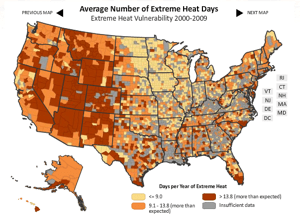Picturing Climate Change in Your County
The National Resources Defense Council has given us a view from above on extreme temperature, smog and allergen pollution, drought and flood vulnerability in the United States for select periods over the last two decades. (more)
The National Resources Defense Council has given us a view from above on extreme temperature, smog and allergen pollution, drought and flood vulnerability in the United States for select periods over the last two decades.
The council’s interactive maps provide a way to search for trends in your own community. Maybe this will generate some constituent telephone calls and emails to a U.S. Congress that remains uninterested in legislating against the economic and industrial practices that cause climate change.–ARK
Your support matters…National Resources Defense Council:
Climate change is one of the most serious public health threats facing the nation, but few people are aware of how it can affect them. Children, the elderly, and communities living in poverty are among the most vulnerable. Click on a state on the map for more information on climate-health threats, actions being taken to prepare communities, and what you can do.
Independent journalism is under threat and overshadowed by heavily funded mainstream media.
You can help level the playing field. Become a member.
Your tax-deductible contribution keeps us digging beneath the headlines to give you thought-provoking, investigative reporting and analysis that unearths what's really happening- without compromise.
Give today to support our courageous, independent journalists.




You need to be a supporter to comment.
There are currently no responses to this article.
Be the first to respond.